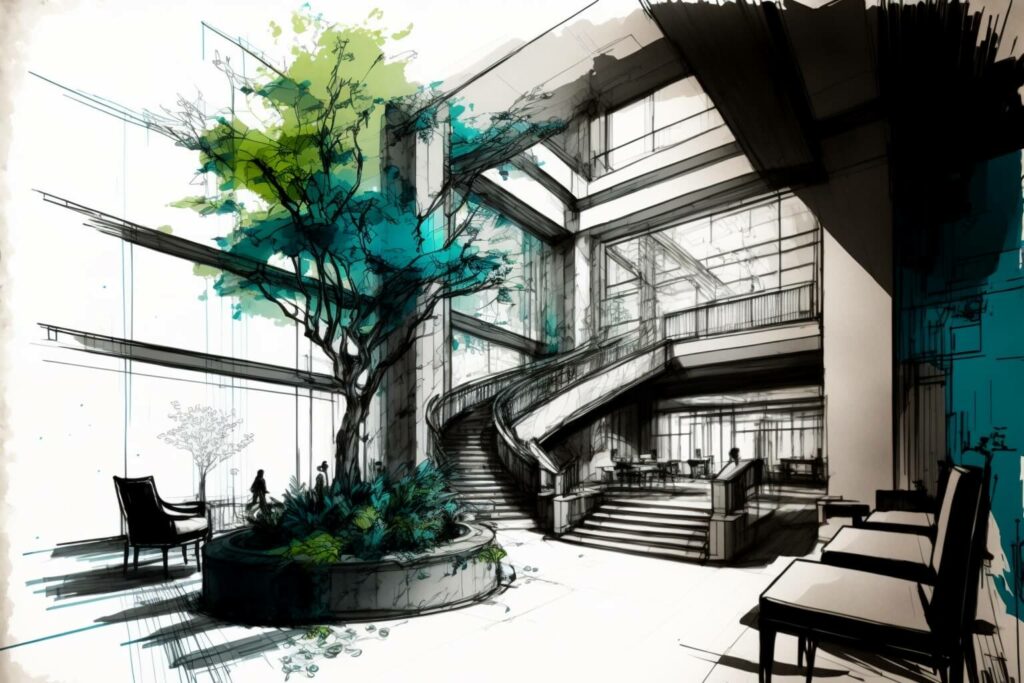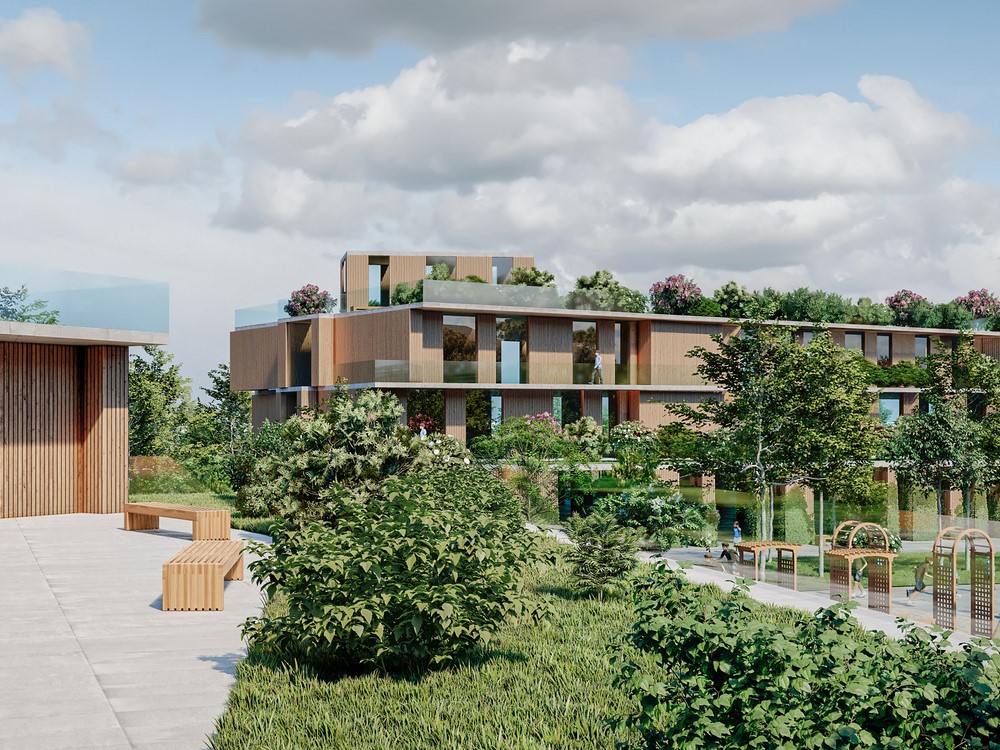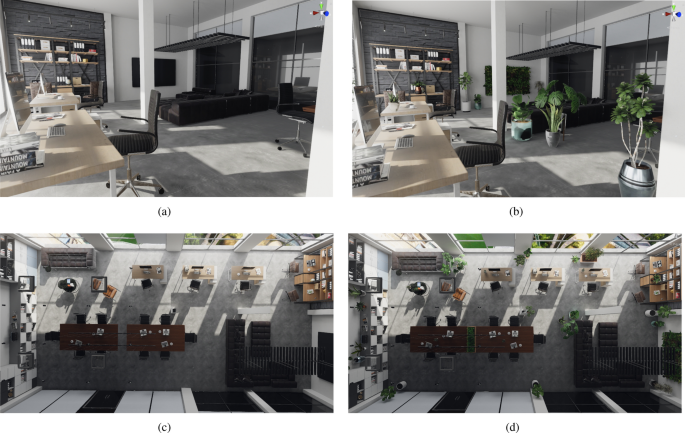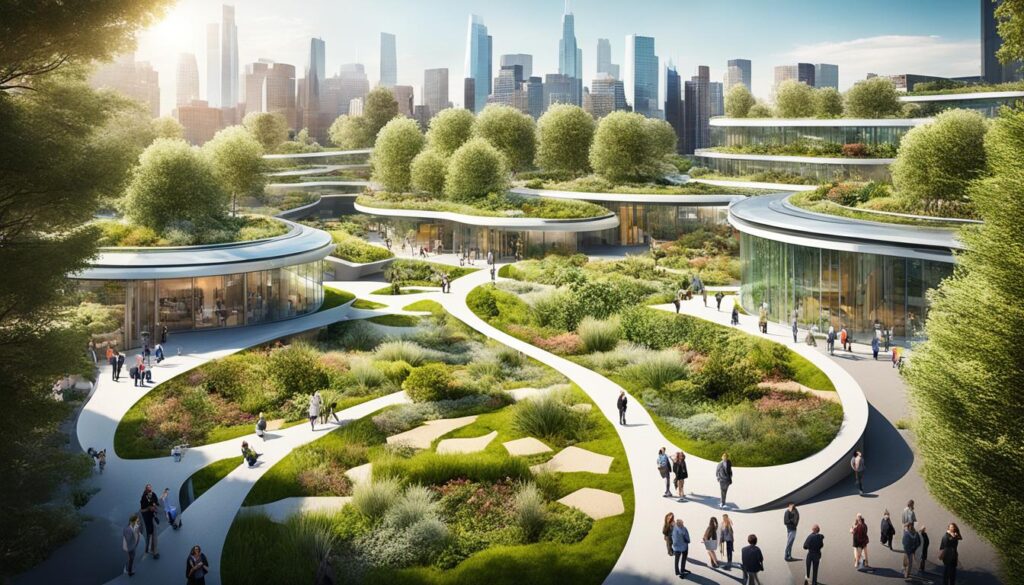The Synergy of Augmented Reality and Biophilic Design: Enhancing the Natural World with Technology
In an increasingly digital world, Augmented Reality (AR) is transforming the way individuals interact with their environments, effectively merging the virtual and physical realms in innovative manners.
This article examines the intersection of AR and biophilic design, an approach that emphasizes our intrinsic connection to nature within modern spaces.
The diverse applications of AR are unfolding across various sectors, including entertainment, education, healthcare, and retail, demonstrating its potential to enhance user experiences.
This exploration will elucidate how these technologies can foster immersive natural experiences, promote well-being, and contribute to sustainable design practices.
Additionally, the discussion will address the potential challenges and future opportunities associated with the integration of augmented reality and biophilic principles.
What Is Augmented Reality?
Augmented Reality (AR) is an advanced technology that superimposes digital information onto the physical environment, thereby creating an immersive experience that enhances interactions with real-world settings.
Through the use of smartphone cameras and sophisticated software, AR integrates digital overlays with the user’s surroundings, presenting distinctive opportunities for engagement across various sectors, including entertainment, education, and healthcare.
This innovative technology is instrumental in visual storytelling and immersive art, promoting a user-centered design approach that fosters a dynamic and interactive connection between audiences and content.
What Are the Uses of Augmented Reality?
The applications of Augmented Reality (AR) extend across various domains, offering effective solutions that enhance user engagement and facilitate immersive experiences.
In the fields of entertainment and gaming, AR transforms gameplay by seamlessly integrating digital elements into the physical environment.
In educational and training contexts, it provides innovative visualization techniques that enhance learning outcomes.
Additionally, AR is increasingly employed in healthcare for surgical simulations and in retail for interactive marketing strategies that elevate consumer experiences.
1. Entertainment and Gaming
Augmented Reality (AR) has profoundly transformed the entertainment and gaming industry by facilitating immersive experiences that engage users in innovative ways. Games such as Pokémon GO serve as prime examples of how AR can seamlessly merge physical environments with digital characters, providing players with distinctive interactions and enhancing their spatial awareness.
This technology promotes playful engagement with the environment, resulting in a dynamic and responsive gaming experience.
Further applications, including AR-enhanced concerts and interactive theme parks, demonstrate the extensive capabilities of this technology. For instance, during live performances, AR can superimpose visual effects and real-time animations, culminating in a multi-sensory experience that captivates audiences.
Immersive experiences within the gaming sector not only provide entertainment but also encourage users to explore their surroundings, thereby promoting physical activity and fostering social connections among players.
By incorporating interactive design principles, these applications effectively bridge the divide between digital and tangible realms, leading to a richer and more engaging experience for users.
2. Education and Training
In the field of education and training, Augmented Reality (AR) offers an immersive experience that facilitates experiential learning by enabling students to visualize complex concepts in a tangible manner. By integrating natural elements and principles of biophilic design, AR can create interactive environments that enhance cognitive benefits and improve information retention.
This approach also fosters student engagement through interactive design elements, making the learning process more compelling.
For example, in science classes, AR can transform a traditional textbook lesson on human anatomy into a dynamic, three-dimensional exploration of the human body, allowing students to interact with organs and systems in real-time. Similarly, in vocational training programs, AR applications can simulate real-world scenarios, providing trainees with the opportunity to practice skills such as electrical work or machinery operation without the associated risks of hands-on training.
These immersive experiences are not only engaging but also give the power to learners to experiment, make mistakes, and learn from those experiences in a safe environment.
3. Healthcare
Augmented Reality (AR) is significantly impacting the healthcare industry by providing innovative tools that enhance user engagement and improve training for medical professionals. Through the use of advanced simulation technologies, medical students can practice procedures in a virtual environment, thereby gaining hands-on experience that mitigates the risks associated with traditional training methods.
This integration of AR not only facilitates skill development but also enhances spatial awareness and comprehension of complex biological structures.
AR serves as a vital connection between theoretical knowledge and practical application, particularly in surgical contexts where precision is paramount. Surgeons can employ AR overlays during procedures, allowing them to visualize critical anatomy in real-time, which contributes to improved surgical outcomes.
Furthermore, patient education has evolved; individuals can interact with three-dimensional models of their own anatomy, promoting a deeper understanding of their medical conditions. With the capabilities for remote assistance, healthcare practitioners can consult with experts from various locations, ensuring that advanced techniques are accessible and thereby transforming the landscape of medical care.
4. Retail and Marketing
In the realms of retail and marketing, Augmented Reality (AR) is significantly transforming the customer experience by providing immersive interactions that enable consumers to visualize products within their own environments prior to making a purchase.
Retailers are utilizing AR technology to develop engaging digital overlays that highlight product features and benefits, thereby enhancing the customer decision-making process. This innovative approach not only drives sales but also cultivates a deeper emotional connection between consumers and brands.
For example, furniture retailers such as IKEA have integrated AR technology into their app, allowing users to place virtual furniture within their homes to assess fit in terms of size and style. Similarly, cosmetic brands like L’Oréal have adopted AR to offer virtual try-ons for makeup, enabling customers to experiment with various looks without the necessity of physical samples.
These campaigns not only illustrate the effectiveness of AR in enhancing user engagement but also significantly increase conversion rates, as potential buyers are more likely to feel assured in their choices when they can visualize products in their own settings.
What Is Biophilic Design?
Biophilic Design represents a progressive approach to architecture that underscores the importance of integrating natural elements into constructed environments to promote emotional well-being and enhance the connection between humans and nature.
This design philosophy seeks to create spaces that facilitate relaxation, improve health, and increase productivity by incorporating features such as natural light, the integration of greenery, and the use of sustainable materials.
The principles of biophilia inform both the aesthetic and functional aspects of indoor and outdoor environments, fostering harmonious relationships between individuals and the natural world.
How Does Biophilic Design Incorporate Augmented Reality?
Biophilic Design and Augmented Reality can be effectively integrated to create immersive experiences that strengthen our connection with nature, enhancing the engagement and aesthetic appeal of physical spaces.
By leveraging AR technology, designers can visualize strategies for integrating natural elements, such as indoor plants and living walls, allowing users to interact with these features in real-time.
This dynamic interaction not only enriches the user experience but also reinforces the principles of environmental psychology and holistic design.
1. Virtual Biophilic Environments
Virtual Biophilic Environments, developed through Augmented Reality (AR), offer users immersive experiences that replicate interactions with nature within their own spaces, thereby enhancing emotional well-being and promoting relaxation.
By integrating digital overlays of natural elements, AR has the capability to transform ordinary environments into vibrant, nature-centric spaces that foster a sense of tranquility and connection to the outdoors. This innovative approach aligns with wellness-focused design principles that prioritize user engagement and sensory stimulation.
Examples of such environments may include virtual gardens adorned with blooming flowers and gently flowing streams, as well as serene mountain landscapes that provide a calming backdrop. These experiences not only facilitate an escape into nature but also promote mindfulness and emotional rejuvenation.
The incorporation of auditory elements, such as birdsong or the rustling of leaves, further immerses users in a sensory-rich environment, effectively mitigating stress and anxiety. Ultimately, these biophilic designs cultivate a holistic sense of well-being by bridging the divide between the digital and natural worlds.
2. Augmented Reality Nature Walks
Augmented Reality Nature Walks represent a distinctive application of augmented reality that seamlessly integrates outdoor experiences with digital interactions. This innovative approach enables users to explore natural environments while receiving informative content through interactive design elements.
The incorporation of technology not only enhances the experience of nature therapy but also encourages participants to engage more profoundly with their surroundings, fostering a deeper emotional connection to nature. By overlaying digital content such as natural sounds and visual narratives, these walks enrich the user experience through heightened sensory perception.
These immersive experiences serve to both educate and inspire mindfulness, facilitating participants’ ability to relax and derive therapeutic benefits from nature. As users navigate trails enhanced with augmented insights, they are able to observe flora and fauna that might have otherwise gone unnoticed, thereby deepening their appreciation for the ecosystem.
This innovative approach to outdoor activities transforms the manner in which individuals interact with their environment, ultimately establishing a harmonious balance between the digital and physical realms. By promoting user engagement and encouraging exploration, Augmented Reality Nature Walks make significant contributions to mental well-being, rendering nature therapy accessible to a wider audience.
3. Interactive Green Spaces
Interactive Green Spaces that incorporate Augmented Reality (AR) possess the potential to significantly enhance community environments by facilitating innovative interactions between residents and nature. AR technology allows users to visualize the integration of natural elements into their surroundings, thereby promoting a deeper understanding of ecological sustainability and environmental aesthetics.
These interactive environments not only encourage social interaction but also foster a sense of place-making, resulting in more vibrant and interconnected communities.
By enabling individuals to explore their local ecosystems through immersive experiences, such applications heighten environmental awareness and cultivate a collective responsibility toward green initiatives. As community members engage with digital overlays that highlight native plants, wildlife habitats, and potential future developments, they are more likely to become actively involved in conservation efforts.
Furthermore, these augmented experiences can function as educational platforms, inspiring younger generations to appreciate and care for their natural surroundings while simultaneously strengthening social bonds among residents. Ultimately, this approach transforms community spaces into dynamic hubs of ecological engagement.
What Are the Benefits of Augmented Reality in Biophilic Design?
The advantages of Augmented Reality (AR) in Biophilic Design are numerous and significant, contributing to improvements in health, productivity, and emotional connectivity with nature.
By augmenting physical spaces with digital representations of natural elements, AR facilitates immersive experiences that can reduce stress, enhance overall well-being, and promote a deeper sense of connection to the environment.
These benefits are in alignment with the principles of ecological sustainability and design innovation, positioning AR as a vital tool in the creation of healthier living and working environments.
1. Increased Connection to Nature
One of the primary advantages of Augmented Reality (AR) in Biophilic Design is its ability to enhance the connection to nature, which can substantially improve users’ emotional responses and overall well-being.
By incorporating AR into designed spaces, users can engage with digital representations of natural elements, thereby strengthening their relationship with the natural world and cultivating a deeper appreciation for environmental aesthetics.
For example, consider a user wearing AR glasses that project vibrant flowers, flowing water, or animated wildlife into an urban environment. This immersive experience not only provides a visually appealing interaction but can also evoke feelings of calm, joy, and wonder—essential emotions that many urban residents may find lacking in their fast-paced surroundings.
By simulating the sensory experiences associated with nature, such as the soothing sound of rustling leaves or the sight of a tranquil landscape, AR effectively bridges the gap between individuals and the environment. This technology encourages more sustainable behavior and fosters a genuine emotional connection with the earth.
2. Improved Mental and Physical Health
The integration of Augmented Reality (AR) within Biophilic Design has the potential to enhance both mental and physical health by creating environments that prioritize wellness and mitigate stress levels.
AR technologies can effectively simulate serene natural environments, thereby promoting relaxation and cognitive benefits that contribute to overall well-being. This approach aligns with the principles of holistic design, which seek to enhance user experiences and foster emotional well-being.
Such immersive experiences not only alleviate symptoms associated with anxiety and depression but also stimulate the senses in distinctive ways, encouraging mindfulness and fostering a deeper connection to one’s surroundings.
The incorporation of natural elements—whether through digital representations or tangible integrations—can significantly improve focus and attention, thereby facilitating the performance of daily tasks.
By bridging the gap between technology and nature, these innovations have the potential to transform spatial utilization, ultimately creating a healthier atmosphere that emphasizes mental clarity and physical health.
3. Enhanced Learning and Creativity
Augmented Reality (AR) significantly enhances learning and creativity within the realm of Biophilic Design by providing experiential learning opportunities that engage users in interactive and immersive manners. The capacity to visualize complex concepts through AR not only fosters innovation but also encourages creative thinking, enabling individuals to effectively explore and comprehend nature-centric ideas. This immersive experience enriches educational contexts and cultivates a deeper appreciation for natural environments.
In various educational settings, including classrooms and nature centers, educators have successfully integrated AR technology to transform traditional lessons into dynamic and engaging experiences.
For example, students can utilize AR applications to overlay digital information onto real-world ecosystems, allowing them to observe plant species and their interrelationships firsthand. This approach deepens their understanding and instills a sense of responsibility toward conservation.
Furthermore, AR technology promotes collaboration among students as they work together on projects that creatively merge artistic expression with ecological awareness. This collaborative effort leads to innovative solutions addressing environmental challenges. The synthesis of creativity and learning not only stimulates curiosity but also give the power tos individuals to become active participants in their environments.
4. Sustainable and Cost-effective Design
Incorporating Augmented Reality (AR) into Biophilic Design results in sustainable and cost-effective solutions by optimizing resource utilization and enhancing the design process. AR enables designers to explore and visualize ecological sustainability strategies prior to implementation, thereby reducing waste and improving efficiency in building projects. This innovative approach aligns with the principles of smart cities and sustainable architecture, promoting responsible design practices.
By allowing designers to simulate various environmental impacts and resource allocations, AR plays a critical role in minimizing material waste and maximizing energy efficiency. It give the power tos designers to make informed decisions, facilitating a comprehensive evaluation of the ecological footprints of their designs.
Through virtual prototyping and real-time visualizations, AR not only enhances collaboration among stakeholders but also aids in identifying potential challenges early in the design phase.
This proactive methodology ensures that projects remain aligned with sustainable design objectives, ultimately fostering a deeper integration of nature-inspired elements that positively influence both users and the environment.
What Are the Challenges of Implementing Augmented Reality in Biophilic Design?
The integration of Augmented Reality (AR) into Biophilic Design presents numerous advantages; however, it also introduces several challenges that must be addressed.
These include technical limitations and the necessity for user acceptance. The technology required for AR can be intricate and expensive, potentially impeding widespread adoption across various sectors.
Furthermore, users may demonstrate reluctance in embracing new technologies, which underscores the need for effective strategies aimed at engagement and education to foster acceptance and comprehension.
1. Technical Limitations
Technical limitations pose a significant challenge to the implementation of Augmented Reality (AR) within Biophilic Design, adversely affecting the overall user experience and the integration of technology. Issues such as hardware compatibility, software reliability, and varying levels of user accessibility can impede the effectiveness of AR applications in creating immersive environments. These challenges underscore the necessity for continuous advancements in technology and user experience design to ensure the successful deployment of AR solutions.
For example, if an AR application requires high processing power, users with older devices may encounter difficulties in running it smoothly, resulting in lag and reduced interactivity. Environmental factors, including lighting conditions and spatial constraints, can further impact the visual integrity of AR content, leading to a disjointed experience. The complexity associated with developing user-friendly interfaces that accommodate diverse user skill levels can also hinder implementation, highlighting the need for streamlined design processes.
Addressing these technical barriers is essential for fully realizing the potential of AR in enhancing the connection between individuals and nature through Biophilic Design.
2. User Acceptance and Adaptation
User acceptance and adaptation represent significant challenges to the successful integration of Augmented Reality (AR) within Biophilic Design, as individuals may exhibit resistance to adopting new technologies.
These challenges often arise from a lack of understanding regarding the potential positive impacts of AR on their environments and experiences. Consequently, innovative approaches to user education, including interactive workshops and engaging demonstrations, are essential for clarifying this technology’s benefits.
Additionally, incorporating feedback loops that allow users to communicate their experiences and challenges can greatly enhance the design process, leading to the development of more intuitive interfaces. By emphasizing technology-driven design principles that prioritize user-centered features, developers can create AR applications that resonate with prospective users.
This focus facilitates a smoother transition to acceptance and encourages exploration of the technology’s possibilities.
3. Cost and Maintenance
The cost and maintenance of Augmented Reality (AR) solutions can pose significant challenges for organizations aiming to implement AR in Biophilic Design, as ongoing expenses may accumulate rapidly.
To address these financial challenges, organizations should explore innovative cost-management strategies that not only streamline the initial investment but also promote long-term sustainability. The integration of AR has the potential to enhance user engagement, ultimately driving operational efficiency and potentially leading to cost reductions over time.
Organizations are advised to consider the adoption of modular AR solutions, which allow for scalable upgrades without necessitating a complete system overhaul.
Furthermore, establishing partnerships with technology providers can offer financial flexibility. By focusing on sustainable architecture—such as energy-efficient hardware and resource-conscious designs—organizations can make substantial contributions to reducing the overall operational expenses associated with these advanced technologies.
How Can Augmented Reality and Biophilic Design Work Together in the Future?
The future of Augmented Reality (AR) and Biophilic Design presents significant opportunities for synergistic advancements that enhance the connection between humans and nature through innovative, technology-driven design solutions.
As AR technology continues to evolve, it will give the power to designers to craft more immersive and interactive environments that seamlessly incorporate biophilic elements. This integration can enrich user experiences and promote emotional well-being.
Furthermore, this collaboration has the potential to drive design innovation, fostering more sustainable and health-centered architectural practices.
1. Advancements in Technology
Advancements in technology will play a pivotal role in shaping the future of Augmented Reality (AR) and its integration with Biophilic Design, leading to the development of more sophisticated and immersive technologies that enhance the user experience.
Improvements in hardware, such as AR glasses and smart devices, combined with advancements in software and cloud technologies, will create new opportunities for designing realistic and engaging environments that prioritize user-centered design.
As these technologies evolve, they will facilitate the convergence of digital and physical spaces, enabling users to interact with their surroundings in unprecedented manners.
By integrating elements of nature through virtual enhancements, designers will foster a deeper connection between individuals and their environments.
Innovative developments in spatial computing and responsive software will further contribute to immersive experiences that promote well-being and sustainability.
This seamless integration not only enhances the aesthetic appeal of spaces but also encourages a more harmonious relationship with nature, demonstrating the transformational potential of AR in contemporary design practices.
2. Integration of AR in Urban Planning
The integration of Augmented Reality (AR) in urban planning offers significant opportunities to develop sustainable architecture and vibrant community spaces that seamlessly integrate the built and natural environments.
By effectively overlaying digital information onto the physical landscape, AR enables urban planners to simulate the impacts of new structures on existing neighborhoods. This technology promotes community engagement in the planning process by providing residents with a clear understanding of how proposed changes may influence their daily lives.
Through the use of interactive models and real-time feedback mechanisms, citizens are afforded the opportunity to articulate their opinions and preferences, ensuring that new developments align with shared visions for sustainable living. As a result, the incorporation of AR serves as a powerful tool for cultivating a sense of ownership and responsibility regarding community spaces, ultimately leading to urban environments that are not only functional but also reflective of the values and aspirations of their residents.
3. Collaboration between AR and Biophilic Design Experts
Collaboration between Augmented Reality (AR) developers and Biophilic Design experts is essential for fully realizing the potential of both disciplines and driving design innovation in future projects. By working in conjunction, these professionals can develop comprehensive solutions that incorporate natural elements, immersive experiences, and responsive design strategies that effectively address user needs while enhancing their connection to nature.
This collaborative approach will deepen the understanding of the advantages of integrating technology into biophilic philosophies.
Such partnerships have already demonstrated remarkable outcomes, as evidenced by projects where AR frameworks overlay digital botanical information onto real-world environments, thereby enriching educational experiences in botanical gardens and urban spaces. Additionally, some developers are incorporating biophilic principles into virtual reality experiences, creating dynamic environments that simulate natural ecosystems.
By redefining how individuals engage with their surroundings, these collaborations not only foster a sense of place but also promote well-being and sustainability.
Ultimately, the integration of technology and nature through such collaboration presents immense potential for transforming spaces into immersive sanctuaries that resonate with the human spirit.
Frequently Asked Questions
What is Augmented Reality (AR) and how does it relate to Biophilic Design?
Augmented Reality is a technology that superimposes digital content onto the real world through a device, such as a smartphone or AR headset. Biophilic Design is the practice of incorporating elements of nature into the built environment. AR can enhance Biophilic Design by bringing virtual elements of nature into the physical space, creating a more immersive and natural experience.
How can Augmented Reality be used in Biophilic Design?
AR can be used in Biophilic Design in various ways, such as creating virtual natural environments, incorporating interactive elements like virtual plants and animals, and providing information about natural elements in the built environment.
What are the benefits of using Augmented Reality in Biophilic Design?
The use of AR in Biophilic Design can provide numerous benefits, including reducing stress and promoting relaxation, increasing productivity and creativity, and creating a more engaging and interactive environment for users.
Are there any drawbacks to using Augmented Reality in Biophilic Design?
One potential drawback of using AR in Biophilic Design is the reliance on technology, which may detract from the natural experience. It is important to balance the use of AR with physical elements to create a harmonious and effective design.
Is Augmented Reality and Biophilic Design only applicable to indoor spaces?
No, Augmented Reality and Biophilic Design can be implemented in both indoor and outdoor spaces. AR can enhance the natural elements already present in an outdoor environment and provide an immersive experience for users.
Can Augmented Reality and Biophilic Design benefit the environment?
Yes, by incorporating AR and Biophilic Design principles into the built environment, it can increase awareness and appreciation for nature and potentially inspire individuals to make more environmentally-friendly choices.

I’m Bruno, an architect with a deep passion for Biophilic Design in Urban Architecture. Throughout my career, I’ve focused on integrating natural elements into urban planning, and I created this site to share my insights and foster a deeper understanding of how biophilic principles can significantly enhance urban living. Dedicated to sustainable development, I continually explore innovative design solutions that promote both environmental and human well-being in city landscapes.














Publicar comentário